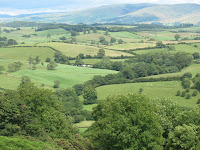On Friday I went out solo in a Seafly, and it was great fun.
I remember not liking the Seafly intially, because of the sound of the water splashing near the front of the boat. Peter Lawson, who makes the boats now, told me on Monday that the shape of the boat pushes the water out to the sides, which makes them sail better, especially in the sea. I found the splashing noise annoying again this day at the start, but either it stopped once the boat was sailing faster, or I did not notice it after a while.
There are other things not to like about the boat; there is no cleat to hold the rudder up, which is only a problem when landing on a beach, and I took off and returned from the jetty; The wooden centreboard was slightly swollen, and very stiff to move up and down; the centre main goes round a loop of rope on the transom, which is only a minor problem following a capsize (you have to duck underneath the get to the back of the boat); Following a capsize it comes up full of water.
Having got all my grouses out of the way, I have to say it is a great boat, and it was a great session of sailing. It was a really enjoyable time, and it was great to get to know the boat and to feel how it handled. It was a very different experience to sailing the Laser on Tuesday, even when the wind grew stonger, there was still time to react to situations. It certainly had a good turn of speed, and was a lot more fun than the traditional boat, or Lune Whammel.
I started off with the two jib sheets tied together with a reef knot, but it came undone, twice. Then I reverted to a figure of eight on each end, but it was a struggle to reach. So then I tied the two ends together with a reef knot but the two figures of eight in place, and that worked very well.
I found the yellow buoy and practised the man overboard procedure, generally I stopped too short, but one attempt worked perfectly.
I practised stopping the boat, keeping the boat turned away from the wind so that the boom was over the side of the boat rather than directly over it. I also put it in the hove-to position, which worked fine the first time, but not the second.
The wind was quite strong by this time, my guess is force 4 rather than force 3 that Jonathan wrote in my log later on. There was only me and a Whammell with a family of four still sailing as far as I could see, although there were still a few canooes.
I felt quite cheated, because I had avoided capsizing through all the sailing, and thought that the hove-to posistion was a safe one, and that adopting it was a responsible action to take in winds that had become quite strong. I was quite dissappointed when the boat gently keeled over, and I dropped into the water. Apparently what was needed was less centreboard, as it is the centreboard that causes the boat to heel.
I was pleased to find that getting the boat righted again single handed was no great problem, nor was pulling myself up over the side. However sailing the boat, which was now full of water, was not a piece of cake, and the controls all felt very heavy. I capsized again almost straight away, and managed to lose the scoop, which floated gently away. By this time Steve had arrived in the safety boat.
I sailed, or limped, most of the way back to the jetty, without opening the flaps at the back that might have emptied the boat of water. I doubt they would have done. Steve showed me how to undo the flaps, and then towed me round in a circle at speed, which did the required job.
The lessons for next time? If someone is available, have a crew; use less centreboard; learn how to put in a reef.


















